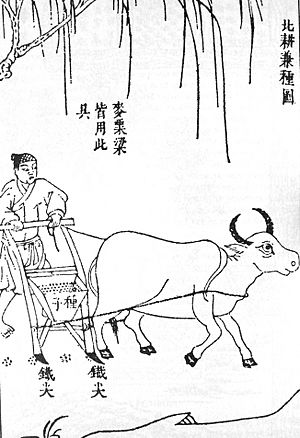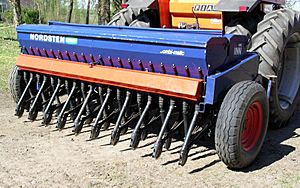Seed drill facts for kids
A seed drill is a clever farm machine that plants seeds in the ground. It places each seed at just the right depth and distance from others. After planting, it covers the seeds with soil. This helps protect the seeds from birds and saves farmers a lot of time and hard work.
When seeds are planted in neat rows by a seed drill, each plant gets enough sunlight, nutrients, and water from the soil. This helps them grow strong and healthy.
A Look Back: History of Seed Drills

People have been using simple seed drills for a very long time. Around 1400 BCE, the Babylonians used early versions. However, this idea didn't spread to Europe back then.
The Chinese invented multi-tube iron seed drills in the 2nd century BCE. These drills were very efficient. They helped China produce a lot of food, which supported its large population for thousands of years. It's possible that this Chinese invention eventually made its way to Europe. In India, farmers were widely using seed drills by the 16th century during the Mughal Empire.
The first known European seed drill was created by Camillo Torello in 1566. It was even given a special patent by the Venetian Senate. Later, in 1602, Tadeo Cavalina from Bologna described a seed drill in great detail.
In England, a man named Jethro Tull improved the seed drill in 1701. This was during a time called the British Agricultural Revolution. However, these early European seed drills were expensive, often broke down, and weren't always reliable. They didn't become widely used in Europe until the mid to late 1800s. This was because new ways of making metal parts, like machine tools, made them cheaper and stronger.
At first, seed drills were small enough for just one horse to pull. Many of these smaller drills were still used even into the 1930s. But then, farmers started using steam-powered, and later gasoline-powered, tractors. These powerful machines led to bigger and better seed drills. Farmers could now plant huge areas of land in just one day.
Newer seed drills can even plant seeds without the farmer having to dig up the soil first. This is called "no-till" farming. It's great for protecting the soil from washing away (erosion) or drying out. The soil stays in place until the new plants grow big enough to hold it down. The invention of the "press drill" was a huge step forward in farming technology before the 1900s.
Some modern seed drills even have special Seed-counting machines built in to make sure the right number of seeds are planted.
Why Seed Drills Are Important
The invention of the seed drill changed farming in a big way!
It gave farmers much better control over how deep they planted seeds. This meant the seeds could get the perfect amount of moisture from the soil. The result? Farmers used less seed but harvested much more food!
Using a seed drill also makes it easier to control weeds. When plants are in neat rows, it's simple to remove weeds with a hoe during the growing season. Weeding by hand is very slow and tiring. If you don't remove weeds, they steal nutrients from the crops, so this benefit is super important for getting a good harvest.
Images for kids
See also
 In Spanish: Sembradora para niños
In Spanish: Sembradora para niños






